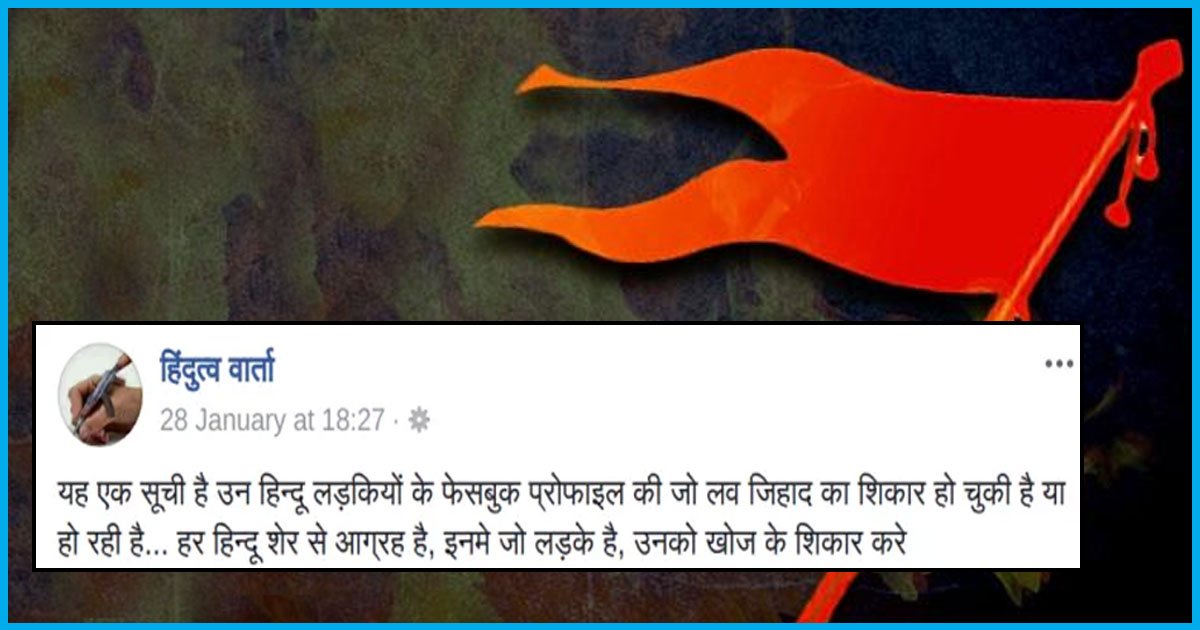
Hindutva Pages That Published List Of 102 Inter-Faith Couples & Called For Violence, Taken Down By Facebook
5 Feb 2018 10:52 AM GMT
All technology is but a tool, and like any other tool it can be used for good or bad in the same way as an axe can be used to chop down wood to start a fire or to kill. This doesn’t mean that the axe or the wielder is to be blamed.
Recently, a Facebook group that went by the name “Hindutva Varta” posted a list of 102 inter-faith couples and called for Hindus to come forward and attack the boys.

This came to light merely days after a 23-year-old youth was stabbed to death in the nation’s capital for having a relationship with a girl of different religion and the Kasganj violence in UP.
The group openly incited violence against members of the Muslim community.
In an article by the Alt News, they revealed that the list has been shared previously in November 2017 as well and a certain “Riddhiman Kunti” has been given credit for compiling it.
Along with the list, the following message was shared:
“Hindu girls are converting to Islam by love jihad (Love Jihad, also called Romeo Jihad, is an alleged activity under which young Muslim boys and men are said to reportedly target young girls belonging to non-Muslim communities for conversion to Islam by feigning love. Wake up Hindus otherwise you will lose your homeland India. Here is a long list of love jihad with their Facebook ID link”.
The post called for Hindus to hunt down the Muslims boys like lions.
Many saw the post and reported it on the social networking site. After Facebook received numerous reports against both Hindutva Varta and Justice For Hindus spreading hate, it took down the pages.
The existence of such hate mongering pages on social media is a horrific reminder of how elements of technology are being absorbed speedily in our society but our mindsets still remain feudal.
Hate mongering on social media
We have all seen at one time or another, different kinds of posts with religious undertones trying to manipulate people. These range from innocuous, mildly ludicrous, downright threats to peace and harmony.
The usual suspects are:
- Using religious imagery to get likes and shares
- In support of some political party or against some other party
- Open hate-mongering using distorted narratives accompanied by fake images/videos
Many instances in recent years got a communal retouch after morphed images and videos were circulated on social media. The instances themselves reflect our social reality. By mixing communal elements in the national debate, all attention is diverted from real issues. Even the government had acknowledged social media being used for hate mongering, “Instances of misuse of Twitter, Facebook, email, blogs and Whatsapp to spread hate campaign in the country have come to the notice of the government from time to time,” present Minister of State for Coal, Haribhai Parthibhai Chaudhary said in 2015.
Existing laws, recommendations and what can be done
Last year, authorities in Varanasi issued a joint order saying that admins of groups on social media will be held responsible for spreading fake news and can be jailed. However, in a Delhi HC judgement, the court said the administrators of WhatsApp and other social networking services cannot be held guilty of defamation if the members of the group post libellous and obscene messages.
Though Section 66 A of the IT Act was struck down by the Supreme Court in 2015 for being draconian in nature, hate pages still exist on social media and users have been jailed for expressing a difference in opinion.
A committee led by TK Viswanathan, who served as director of ADR, ICADR and as secretary-general of the Lok Sabha, was formed to look into the menace related to social media.
The Supreme Court of India in Pravasi Bhalai Sangathan Vs Union of India directed the Law Commission of India to look into the issue of hate speeches. [The result, ‘Report 267’, can be viewed in full here.]
“The Commission opined that hate speech generally is an incitement to hatred primarily against a group of persons defined in terms of race, ethnicity, gender, sexual orientation, religious belief and the like (sections 153A, 295A read with section 298 IPC). Thus, hate speech is any word written or spoken, signs, visible representations within the hearing or sight of a person with the intention to cause fear or alarm, or incitement to violence.”
“Keeping the necessity of amending the penal law, a draft amendment bill, namely, The Criminal Law (Amendment) Bill, 2017 suggesting insertion of new section 153C (Prohibiting incitement to hatred) and section 505A (Causing fear, alarm, or provocation of violence in certain cases) is annexed as Annexure-A for consideration of the Government,” reported Live Law.
Keeping this report in mind, the Viswanathan committee came out with its recommendations which included:
- The report has suggested that Section 78 of the IT Act needs to be substituted and Section 153 and 505A of the IPC need to be amended.
- “Throughout the world now hate speech is being handled by suitable amendments to the law. Germany has come out with a Network protection Act, New Zealand has the Harmful Publication Act, and hence we also have to deal with that. In the process we also tried to take support from the Law Commission report on hate speech.” The report was published after Section 66A was struck down.
- “Section 66A was too broad and the problem with our law enforcement agencies is that we don’t have a separate agency to deal with cybercrimes… In absence of the capacity building, I have suggested the formation of cybercrime coordinators to prevent abuse. In every district there will be a cybercrime coordinator and in every state there will be one too,”
Currently, hate speech provisions are found in three different chapters of the IPC, “Of Offences Relating to Religion”, “Of Offences Against the Public Tranquillity” and “Of Criminal Intimidation, Insult and Annoyance”. The higher courts have been careful to interpret these in the spirit of democracy which champions free speech and expression of disaffection and preventive and punitive measures to be resorted to only when there is a clear incitement to violence and threat to person/persons or public safety.
The way forward
The truest measure of a democracy is its ability to tolerate dissent. Labelling genuine critique of government as anti-national or anti-Hindu is highly regressive and meant to digress from the real discourse. It was after decades of struggle that Indians gained freedom from the rule of the British and now in an independent India, the democratic basis is becoming quasi-authoritarian in nature.
Opportunists, political leaders and hate mongers use our religious inclinations for communalism. The main difference between religion and communalism is – religion is a something personal choice and communalism is targeted hatred of the other community.
Over-policing of social media is not the answer because the internet plays a crucial role in advocating for free speech. Apart from self-policing, actions against those who incite violence need to be taken. But the reality is such that cartoonists, genuine reporters and peaceful protesters are jailed, giving fringe groups a greater sense of impunity.
Women face the brunt of internet trolls. As one sociologist puts it, “no religion has been particularly good to women”. We need to engage in dissent without spreading hate or inciting violence. Let’s not let our democracy be reduced to a bigoted state where people’s lives are at stake for voicing an opinion different from the majority’s.
 All section
All section















